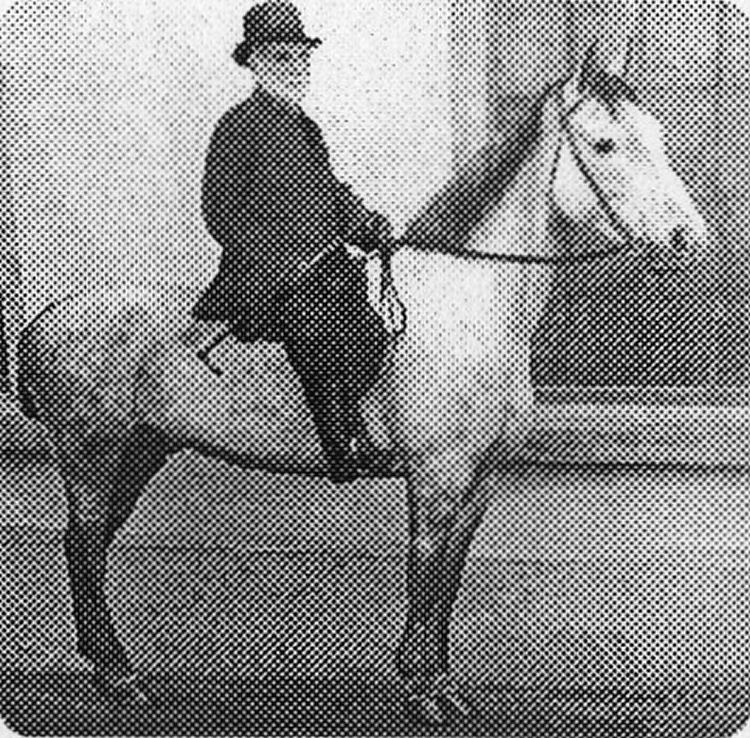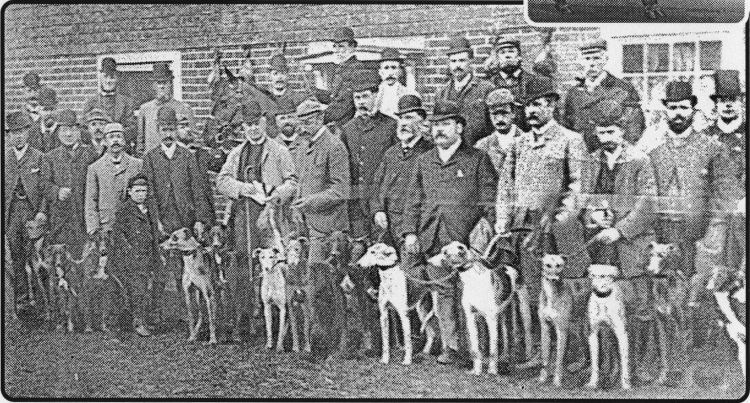
Published 17 October 2002


m
Pioneers
WINGING its way 'down under' via e-mail recently was a photocopy of an
article from the Herald's onetime midweek paper, the Folkestone St Hythe
Gazette, of June 10, 1964. I made the copy for veteran Memories reader
Margaret Hogben, of Folkestone, who sent it to South Australia.
Printed in "The Townsman's Diary," it told of an interesting link between
Acrise and the Ladd family in California. This was highlighted by the then
Rector of Hawkinge, the Revd J.E.T. Cox, in his monthly magazine "The Sword"
Margaret had a copy of the Folkestone Gazette article, but over the years
part of it had been lost and she needed a photocopy.
The article told how a newly-built staircase to a gallery in the west end of
the little church of St Martin, Acrise, had been made by village craftsman
Edward Bailey, while most of the cost had been met by the Ladd family in the
U.S.A.
The Acrise Ladd family were among the pioneers of the West who eventually
reached California and may well have been related to the pre-1970s film
star, the late Alan Ladd.
Ladd ancestors held the Acrise property, "Ladwood" centuries ago. and
adopted this name for their farmstead when they later settled in America.
Years later descendants came to Hawkinge tracing their "family tree" and
were so impressed by the church they sent a donation which helped to make
possible the new staircase.
A firm friendship developed between the Patrick family, owners of Ladwood
Farm, north of Acrise, and the American branch of the Ladd family.
Then one day three elderly ladies from Tasmania
called at the farm. They too, believed their ancestors came from Ladwood,
Acrise. Advised by Bill Patrick to contact Donald Ladd in California, they
discovered they were cousins!
Craftsman Edward Bailey himself was born at Ladwood. his family farming
there from the 19th Century until 1946.
Margaret Hogben is a Lade descendant and this year she met fellow Lade
descendants, Joan and Jack Warin. from South Australia, through a remarkable
chance meeting the visitors had with a Hythe friend of Margaret's while on
holiday on a Scottish island. (Decades ago some of the Ladds appear to have
adopted the spelling of Lade.)
When Margaret's friend Iris told the Warins she came from Hythe Joan Warin
revealed that an ancestor, possibly her great-great-grandfather, named Lade,
once had the Bell Inn in Hythe.
Poignant travelogue
Margaret and her sister had Lade relations in Australia and arranged to meet
the Warins on their next visit to England - and it transpired that they were
related through Stephen Lade (1785-1869) and Frances Lade, her great-great
grandparents.
Among Margaret's family records is an 1865 letter written by this couple's
daughter, Juliana Hodgman, wife of Aaron Hodgman, while she was en route to
Australia by sea with her young family.
The sometimes graphic account of conditions and food on board, covers a
period from June 11, when they were seven weeks into their voyage, to July
25 1865 when she wrote that they were rapidly nearing Australia.
From a further brief note dated August 18 it would appear they had by then
arrived safely, but it doesn't say where.
)
Since Margaret and her sister met the Warins, they have exchanged
information and Joan Warin has sent her a copy of her family tree and copies
of treasured pictures of mutual ancestors.
Now Margaret has sent her new-found relative a copy of the Herald article to
see if any of the information fits into the family jigsaw puzzle.
I only hope that in years to come the simple old church does not suffer the
fate of Swingfield's fine, but "redundant" village church, now, apparently,
due to become a private house.
A century ago...
Chairman of the Friends of Lydd group. Miss Alice Boxall was very interested
to see my recent refer-
ence, to a presentation made at Dymchurch a century ago. The 1902 Herald
report told how John Jones, of Dymchurch, was presented with a framed
painting of himself mounted on horse back, by a group of fellow Romney Marsh
"Lookers" and Bailiffs to mark his 40 years involvement in hare-coursing,
hunting and shooting.
Miss Boxall told me the painting can be seen at Lydd Museum, which also has
a framed group photograph of the hare coursing fraternity (see photo above)
who commissioned the painting. She kindly sent me photos she took of both.
One of the reasons I referred to the presentation in "From Our Files" is
that the Herald published a photograph of the painting at a time when
pictures were very sparingly used in local papers.
A CENTURY ago at Lydd hare coursers were celebrating with one of the old
Marsh "Lookers," John Jones, the old gentleman with a white beard, seated on
horseback, who had completed 40 years coursing. This picture is a copy of an
original photo in Lydd Museum which was shown to me by Miss Alice Boxall,
the chairman of the Friends of Lydd, along with a portrait (top) referred to
below in "A century ago...."
 |
Costly trips to see trams on Continent questioned
«f Q/\*> READERS were questioning the quali J.»/V/fcfications of 13
members of the Town Council to decide 011 the best system of electric
tramway, with "underground traction" (presumably meaning power under the
tram tracks) for Folkestone, after the council decided they should
inspcct systems on the Continent and elsewhere - Brussels. Paris,
Berlin, Wolverhampton and Liverpool being mentioned. He doubted if even
one had the knowledge required to make a sound judgement, wrote the
ratepayer. The following week an Alfred Thorogood, of Hundert's Hotel,
wrote pointing out the information the Council required to come to a
decision could just as easily be obtained "for the asking" from other
councils which had already carried out such inspections and for the same
purpose And the same writer sang the praises of the tramway at Southsea
- "better than any on the south coast and Brussels." The local Buffs
company of volunteers was appealing for more cycling recruits. Cycle
mounted soldiers were in vogue a century ago. As an incentive to join
there was a programme of social events.
|
‘Sally’ Army celebrations recall storniy days of past
«t FOLKESTONE Corps of the Salvation
.LiJO^ArmY was due; to celebrate its 70th birthday from November 15-17,
the mayor and corporation to attend a servicc on the Sunday. History
shows that, in its infancy, the Corps met hostile opposition from an
earlier mayor and the early Salvationists had to run the gauntlet of
stor 10 throwing and riots by an unruly mob. The town raised £1,000 in
aid of the Lynmouth flood disaster relief fund. The Herald told of the
acquisition by the Folkestone Museum of an oil painting of the brig "Pelter"
which was lying in East Wear Bay from about 1832-62, and was long used
as a residence for thu coastguards. It was thought to have been built at
Bideford in 1813. The picture is by Dover artist Charles Augustus
Mornewick senior. Another artist. George Wallis, later Keeper of the art
collection at South Kensington Museum, painted the captain of
coastguards. Mr Campbell, in his cabin on board the Pelter 111 1862.
Coastguard cottages later superseded the brig. Mrs Mildred Poole, of
Brockman Road won a B.A.C. "Lilliput" motorcycle in a "Spot the
Spelling" con tost which was part of the town shopping week. Approval in
principle was given to the opening of a crematorium at Hawkinge
cemetery.
|
Four-day trips to Belgium by steamer for under £4!
«|Q<f}>«THE Silver Queen Motor Service, I which once garaged its coaches
at the former airship station at Capel, was offering weekend trips from
Folkestone to Ostend via Dover with coach trips to Ypres and to Bruges
and Holland, via Zeebrugge, leaving on Friday and returning on Monday
evening. The cost: under £3.50! A local man calling for more control of
sea fishing recalled how fish stocks in the Channel had built up again
during restrictions enforced by the First World War, because many more
young fish were able to grow to maturity. The Herald carried a picture
feature on the new premises in Sandgate Road, of The Farmers'
Association (Folkestone) Ltd, incorporating an interesting photo of
three-wheeled dairy carts and a bicycle at the Pleydeli Gardens dairy.
In the same issue was news of the destruction by fire of Lydd windmill,
built in 1801. Owned by J.T. Goble JP, it was a valuable landmark for
shipping. W.H. Elgar told the story of John Salmon, Chancellor to King
Edward II and Bishop of Norwich, who died in Folkestone after a mission
to France to try and keep the peace.
|
Beware turning town into backwater with precinct
A CI77* FORMER mayor of Hythu. Gerald P I I Walter was claiming the
creation of a "chaotic maze of one-way streets" in Folkestone and
cutting Sandgate Road in two with a precinct, was largely to blame for
the decline of the town. His comment came as he warned about the risk of
something similar happening in Hythe. This followed the decision, on the
casting vote of a Folkestone councillor, to recommend Hythe should have
a pedestrian precinct. He warned the vast majority of people would only
shop where there was easy access by car. It should be possible, he said,
to divert through traffic away from Hythe High Street without turning
the town into a back-water. The hype had begun to persuade people that
Shepway would be much better off. health wise, when the new William
Harvey Hospital opened at Ashford. However, hopes died of retaining a
12-hour casualty service at the "Vic." There could still be minor
injuries cover at the old Royal Victoria Hospital, which would retain 20
beds for local patients and would also have better outpatient and
physiotherapy departments., it was planned. A new £2 million sewage
treatment scheme would end the discharge of untreated sewage into the
sea off Hythe. |
|



